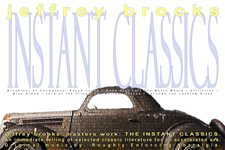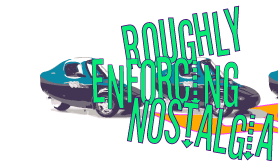|
 "Ars Arbitrarica: A Manifesto on Instant Classics"
"Ars Arbitrarica: A Manifesto on Instant Classics"
(1:30)[1/27/00]
By Roughly Enforcing Nostalgia
Jean-Luc Goddard once wrote, “The best way to criticize a movie is to make another movie.” Win Wenders once said, “I direct films because there is nothing else.” My brother, Dan Jeremy, and I started the “band” Roughly Enforcing Nostalgia to criticize the pop music landscape, while at the same time putting our own ideas on the line for others to critique. One of the several projects we’re currently working on include the Instant Classics, which was inspired by the supposition that the modern human attention span has been shrunk to 90 second sound bites and bumper stickers. The Instant Classics are an exploration on what precisely is lost and gained in this process. By attempting to boil down famous literary works to a minute and a half concentrate of lyrical summarizing set to (often experimental) music, we’re exploring a concept that seems absurdly doomed, while trying to create the rarest of rare birds: sound art that stands up to repeated listenings.
The three songs which are presented were titled after their respective books: Death of a Salesman, Being There, and Naked Lunch. The first piece is a mid-tempo, straight-forwardly arranged tune comprised of the standard pop structure: Intro, Verse, Chorus, Bridge, Verse, Chorus. The lyrics tell the familiar story of everysalesman Willy Loman, and his relationship with his sons, a pair of frustrated farmhands trying to achieve social status in the progressively more urban landscape of New America. To his sons, Willy represents the quintessential go-getter whose hard work has never paid off, “the nice guy who finishes last.” In the New America, corporations have no memory of allegiance to their long-term employees, whom they don’t recognize owing a debt to. In turn, Willy’s sons feel no loyalty to their companies, stealing materials from their employers as a sort of pre-emptive strike for what they feel is sure to happen to them too. As the chorus rings out “Promises made across this desk, / So now you musn’t tell me you’ve got people to see,” we hear a cheated Willy coming to the realization that there’s no social contract (or social security) for him; in this changed society, all previous promises have become rendered as obsolete as Willy now is in his old age. If Willy is unable or too expensive to be used by the company, they’ll easily find a new, cheaper grunt to take his place: “There’s one born every minute,” and it doesn’t matter who.
“Death of a Salesman”’s musical technique was based around the idea of primarily using instrumentation from Microjammers toys, manufactured by Cap Toys Incorporated. This line of eight-inch plastic toys comes in the shape of different popular instruments, each having six buttons (on the “valve” or “fret”, etc.) which, when pressed, produces a pre-recorded sound snippet of the appropriate instrument. Three of these toys were recorded, sampled, and looped as the main instruments for this project. We found these products for sale at a Noodle Kidoodle toy store for $6.99. When you take into account this rather reasonable price versus the cost of bringing in a professional session musician at anywhere from $50-200 an hour, the choice becomes clear: the quality is comparable (to our thinking), the price is much lower, and the help is more pleasant to work with. Of course, the heartless kind of logic written above is said in jest, considering the fact that one man has spent the better part of his life honing and perfecting his craft to virtuoso level, only to have it recorded and shipped out from China as a child’s toy. But what is interesting is the probablity and realistic potential this brand of thinking could have at a board meeting somewhere.
Our reasons for using Microjammers toys for “Death of a Salesman” are probably obvious by now: we were trying to show how faceless and arbitrary the music and radio industries (as well as most worldwide industries, for that matter) have become. The hitmaking mentality of modern music reinforces the notion at work behind Ray Sharkey’s character in The Idolmaker, in which anyone can be a superstar with the right look and the right promotion. No person is indispensable in the great machine of business, and in the same way that Willy Loman is unimportant as an individual cog in the scheme of things, the same is true for the anonymous musicians of Cap Toys Inc, as the same is true for the interchangable superstars of Phil Spector or Berry Gordy’s Motown.
“Being There” is based on the Jerzy Kosinski novel of the same name, the story of a dim-witted but earnest adult gardener named Chance whose wealthy caregiver (known only as the Old Man) dies, leaving him to face a hostile Washington DC for the first time. Knowing only gardening and what he’s seen on television, he’s almost immediately hit by a car and taken for recuperation back to the Rand mansion by an apologetic Eve. Her husband, Ben Rand, is a popular and respected tastemaker who has influenced the image of several US presidencies, but is now in failing health, and in need of a new guardian for his wife. Chance’s simple floral metaphors impress Ben’s good friend, the President, and Chance (called Chauncey Gardener by mistake) becomes the toast of the town and a major political player of presidential aspirations.
Our music for the song of “Being There” has two major influences: One is based on the much-lauded, rarely-sat-through idea of John Cage’s prepared piano pieces, in which various keys of a piano were replaced by other non-traditional and percussive sounds, such rubber duckies, music boxes, etc. The second major influence is based on theories by Charles Ives concerning pieces expressly written for marching bands in which multiple bands collide sonically, either by playing opposing songs, or by staggering the beginnings of each section of the same song to be performed. (Once again, in theory very interesting, but in practice falling way below the listening level of John Q. Public.) What we did was similarly arbitrary, in that the original scores, written some fifteen years ago by us on an outdated MIDI system, were, when recently transfered to the new standard system, changed to new, totally random instrumentalization. When played, these newly-transferred MIDI versions emitted a mess of unplanned, cacophonous noise, which was the actualization of the kind of random musical vandalism that Cage and others of his chaotic ilk were working towards.
In the same way that Being There (the novel’s) protagonist is symbolic for the arbitrary forces at work in everyone’s lives, “Being There” (the song’s) musical origin was based solely and unhamperedly on chance, almost as if we had programmed in the notes that we wanted played, which the computer randomly put in nonsensical order (as is the case so often with temperamental computers). The other goal of this song was to satirize the idiocy of Cage-worshippers who put more emphasis on theory than on listenability of the finished product. Just as Kosinski’s Chance is never discovered to be a simpleton, the same seems to true (to our way of thinking) for those who swallow these post-everything notions on sound and art hook, line, and sinker.
The final piece presented was “Naked Lunch”, which was a lyrical attempt to employ the same techniques of “automatic writing” employed by William S Burroughs during the writing of that novel. By the start of 1980’s, Buroughs was universally revered by those “in the know” as a cult figure of magnanimous proportions. The main reason for this recognition was in relation to a style of writing he, if not invented, then certainly popularized in the late ‘50’s known as “cut-and-paste.” His Naked Lunch was written during a stint of approximately a year in Tangiers, in which he shot up a fair amount of junk and stared at his shoe, getting up only to tie-up or to write bizarre “reports”, in which he refered to himself as an agent of Interzone working undercover. These reports, mailed to writer friends, formed the basis for the sporadic prose collection that is Naked Lunch. What we did for our “Lunch” consists of lyrical free-association on the color blue (amongst other subtopics and tangents related to Burroughs’ writing process) which was not edited or self-censored in any way during its creation.
Percussive elements to “Naked Lunch” followed a similar schema. We used found sounds from our garage, such as the woosh of a pilot light igniting a furnace (employed as the b-b-bass drum), the crunch of accidentally kicking over an ancient box fan (used as the two and four hits as the snare), the scritchity-scratch of a nylon jacket over a microphone (used as additive percussion), the thadrrat of a mic being drug over a grate, the clanking of a gas pipe on concrete floor, and the pop-smack of close-miced lips for a sound check. On top of these percussive loops was smothered a growling guitar, which was placed on an old wooden plank atop of a shitty practice amp in our darkroom’s sink. The bassed frequencies of the amp eventually grew in intensity and matched the harmonic of a single string, “plucking” the string and shaking its diving board foundation, which fed into this cannibalistic cycle. (This idea owes some theoretical similarities to Alvin Lucier’s studies, which he titled Music On a Long Thin Wire.) Other loops were then added to the mix for additional musical grounding.
“Naked Lunch” was meant to be as pure as possible an example of cut-and-paste writing and composing: Very little skepticism, censoring, or questions as to whether or not this was a good idea were to be found. The song was meant to have a tossed-together feel, a stream-of-consciousness electronic jam session in which the man turning the knobs is more important than a musician, a song which was to remain true to the style in which the original novel was constructed.
In each of these Instant Classics, the concepts of chance and arbitrary instrumentation shoot through the whole endeavor. What we’ve tried to do with the Instant Classics is to create sound art which is interesting yet palatable, and is just as at-home in your car’s CD player as in a museum’s gallery or in a textbook for an art history class. We at Roughly Enforcing Nostalgia want to jump off the cliff, but we first want to be certain that we can get to the other side. We’d like to expand the possiblities, staying in touch with John Cage without completely losing touch with John Q. |
|















